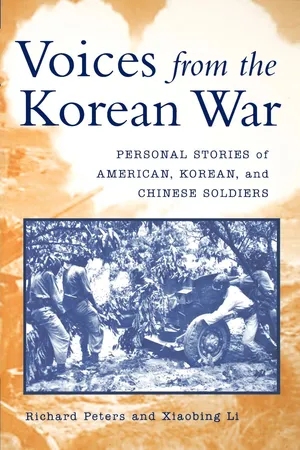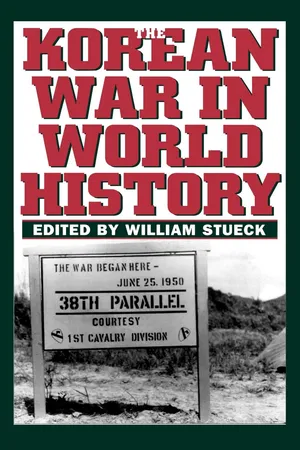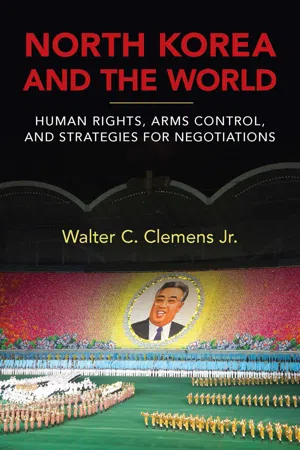History
Causes of the Korean War
The causes of the Korean War can be attributed to the division of Korea after World War II, with the North being influenced by communism and the South by capitalism. Tensions escalated due to border skirmishes and ideological differences, leading to the outbreak of the war in 1950. The involvement of global superpowers, particularly the United States and the Soviet Union, further fueled the conflict.
Written by Perlego with AI-assistance
Related key terms
4 Key excerpts on "Causes of the Korean War"
- eBook - ePub
Voices from the Korean War
Personal Stories of American, Korean, and Chinese Soldiers
- Richard Peters, Xiaobing Li(Authors)
- 2014(Publication Date)
- The University Press of Kentucky(Publisher)
Part One The Korean War A Short HistoryPassage contains an image
Chapter 1
Background and Origins of the WarIt is one of the more unfortunate and ironic events in history that Korea, a nation that prior to 1945 included the most homogeneous and united of all peoples, should become a nation divided. Whatever differences may have existed in regard to caste or class, the Korean people speak the same language throughout the peninsula and, with minor variations between north and south, are of the same culture. This cruel fate is made even more tragic by the fact that the Korean people were divided by other powers—clearly the victims of Cold War politics.1The tragedy of Korea, however, began long before the Korean War. Thanks to victories over China in 1894 and Russia in 1905, between 1905 and 1945 Japan governed Korea as a colony, with the blessings of Great Britain and the United States. The Japanese ruled harshly and backed up their policies with brutal police and army forces as they strived to destroy all vestiges of Korean culture. While Korea did make economic progress under Japanese rule, the political climate remained repressive. In the words of one historian, “Japanese imperialism stuck a knife in old Korea and twisted it, and that wound has gnawed at the Korean national identity ever since.”2The Japanese occupation was made even more difficult for Koreans to accept by their close cultural ties to China and their view of the Japanese as products of inferior culture. Partially for these reasons, in the end the Japanese were unable to extinguish Korean culture and nationalism. When World War II ended in 1945, Korean nationalists, bonded by their common hatred of the Japanese, competed for leadership in the attempt to establish a free and independent Korea.3 - eBook - ePub
- William Stueck(Author)
- 2010(Publication Date)
- The University Press of Kentucky(Publisher)
The desire to avoid repeating the disaster of the appeasement of Nazi aggression in the 1930s was so keen that sixteen nations agreed to intervene to repel the invasion, fighting under the flag of the United Nations. The question of Soviet responsibility for the attack has therefore rightfully been at the center of historical analysis of the war’s origins. Writings on the war in the 1950s and 1960s, most prominently David Rees’ history of the conflict, 1 followed policy makers in assuming that the Soviet client state in Korea had neither the physical means nor the political autonomy to launch a large-scale military offensive on its own. The journalist I. F. Stone challenged that view as early as 1952, 2 but until the release of Western documents in the 1970s prompted a new wave of literature on the war, his remained a minority view. The most influential of the revisionist historians whose work dominated the field in the 1980s, Bruce Cumings, concluded on the basis of newly released American documents that although Kim II Sung probably consulted with Stalin, he planned and carried out the attack largely on his own. Cumings also concluded that the North Korean action may in fact have been a response to a Southern attack, as the communist countries had always maintained, a provocation perhaps orchestrated by Chinese nationalists and by Americans eager to reassert a U.S. military presence in East Asia. At any rate, he argued, the war can best be explained as a civil war, a continuation of the violent struggle between the political right and left in Korea that had begun with the collapse of Japanese colonial rule in 1945 - eBook - ePub
- Steven Hugh Lee(Author)
- 2013(Publication Date)
- Routledge(Publisher)
In order to come to a fuller understanding of war, then, we should explore not only the origins and political outcomes of conflict, but also the complex social and cultural interchanges between the soldier, his or her society, and the ‘enemy’. The history of the Korean War provides us with such an opportunity. The brief North Korean occupation of southern Korea in 1950 is unintelligible without an understanding of the political structures and social goals which were embedded in the pre-1950 northern experience with anti-Japanese guerrilla warfare and social revolution. Significant changes in race relations which were beginning to occur in the United States shaped the lives of US soldiers on the peninsula. And prisoners of war on both sides were subjected to propaganda which reflected dominant cultural and political values and ways of thinking in the countries of their captors. We shall examine these and other themes as a way of illuminating the reciprocal relationship between war and society during the Korean conflict.Wartime Korea, 1950
The Korean War was not a conventional military conflict, fought between professional standing armies in large-scale battles. It was a hybrid struggle which combined massive firepower – especially on the UNC side – with guerrilla warfare. The war's character was apparent from the initial North Korean advance. Although the Soviet Union provided tanks, and Russian military advisers played an important role in formulating North Korea's offensive strategy, a large percentage of the attacking troops were seasoned veterans of unconventional civil warfare in rural China. These battle-hardened soldiers were accompanied by guerrilla forces operating in tandem with the DPRK Army. During the summer of 1950, groups of up to 3,000 guerrillas fought alongside the ‘regular’ army forces.As northern armies penetrated deeper into the south in the summer of 1950, North Korean political cadres moved into occupied areas and began to shape local politics in the image of the DPRK regime. Leftist people's committees which had been disbanded by the American Military Government in 1945 and 1946 were reconstituted. North Korean propaganda emphasized the south's ‘liberation’ from the American-sponsored ‘puppet’ regime of Syngman Rhee and glorified the role of the Korean People's Army, which was portrayed as a guerrilla organization that had fought valiantly against Japanese imperialism. Significantly, this northern propaganda made few references to the indigenous South Korean communist movement before 1945. The clear leader of Korean communism was now Kim Il Sung, not Pak Hon Yong, and the brand of communism imposed on the south was one borne of the Manchurian guerrilla conflict against Japan in the 1930s. - eBook - ePub
North Korea and the World
Human Rights, Arms Control, and Strategies for Negotiation
- Walter C. Clemens(Author)
- 2016(Publication Date)
- The University Press of Kentucky(Publisher)
Tensions between Stalin and Mao affected their willingness and ability to assist and channel Kim Il Sung’s North Korea. Even when weak and unsteady, both the DPRK and the ROK usually managed to go their own ways. Both Seoul and Panmunjom proved adept at manipulating the larger states that financed, armed, and backed them diplomatically.All this formed the context for the increasingly important roles played by North and South Korea on the global stage.Passage contains an image
5
How a Civil War Became Global
He calls it Reason, but uses it only to act more beastly than any animal. (Er nennt’s Vernunft und braucht’s allein, nur tierischer als jedes Tier zu sein.)—Mephistopheles to the Lord in Goethe’s Faust (lines 285–286)The partition of Korea left the peninsula with two governments, each determined to unify all Koreans under its rule. Korea was not a priority for the Kremlin or the White House: each focused more on its nuclear arms competition and on Europe. Still, Stalin gave a green light and equipped the DPRK to invade South Korea in June 1950. Despite earlier signs that Korea lay beyond the U.S. defense perimeter, the Truman administration dispatched U.S. forces and acquired UN approval to drive back the North Korean invaders. Feeling threatened, China joined the fray. The USSR sent pilots as well as arms to sustain DPRK and Chinese forces. After three years of combat, the parties signed an armistice in July 1953. The putative lessons and consequences of the Korean War ricocheted around the globe.NORTH KOREA PLAYS ITS SOVIET AND CHINESE CARDSEach leader—Kim Il Sung in the North and Syngman Rhee in the South—struggled to unify Korea under his own rule. Starting in 1949, if not earlier, Kim Il Sung importuned Stalin on several occasions for permission to march North Korean forces across the 38th parallel and unify all Korea. The DPRK leader assured Stalin that Communists in the South would mobilize popular support for unification with the Communist North. However, neither Stalin nor Mao Zedong wanted a war on the Korean peninsula that might bring U.S. forces to their doorstep. Stalin initially rejected Kim Il Sung’s appeals, but changed his stance after the USSR successfully conducted a nuclear explosion and after Communists took control of China. In January 1950 Stalin instructed Soviet ambassador Terentii F. Shtykov to inform Kim Il Sung that the USSR stood ready to assist his campaign to liberate the South, provided that it be organized to avoid U.S. intervention. Stalin authorized the dispatch of 400 senior Soviet officers to plan the war. He also dictated such details as whether the DPRK could issue a bond, form an additional three infantry divisions, convene the Supreme People’s Assembly, or send textile workers to the Soviet Union for training. Still, Stalin did not want a major war on the Soviet doorstep that could also lead to war with the United States or a renewed threat from Japanese militarism.
Learn about this page
Index pages curate the most relevant extracts from our library of academic textbooks. They’ve been created using an in-house natural language model (NLM), each adding context and meaning to key research topics.



